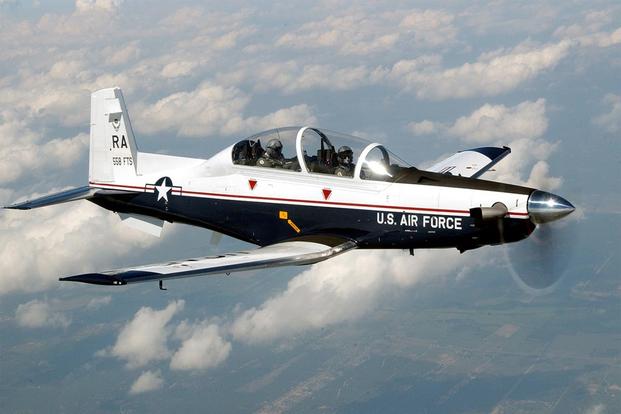Air Force officials say they have identified a fix to problems in the T-6 Texan II trainer aircraft that were making pilots short of breath and resulted in a month-long fleet grounding in February.
Following a six-month investigation, Air Education and Training Command announced Thursday that a team of experts including Navy, Air Force and NASA personnel had pinpointed the issue as a fluctuation in oxygen concentrations in the cockpit while the trainer aircraft was in flight.
To fix the problem, officials said, a series of corrective measures has been identified, including redesigning the aircraft's oxygen system and adjusting oxygen control levels in flight. AETC also plans to ramp up maintenance on the aircraft's onboard oxygen generation system, or OBOGS.
"So far, technical efforts to date and analysis of data collected have determined that pilots have been exposed to significantly changing levels of oxygen concentration," Lt. Gen. Steve Kwast, commander of AETC, said in a released statement. "The varying levels of oxygen concentration, even though in excess of what the body typically needs, [have] caused physiological stress that most pilots on most days actually adapt to without noticing."
Following a series of what the Air Force calls unexplained physiological episodes, or UPEs, the commander of the 19th Air Force, Maj. Gen. Patrick Doherty, announced in February 2018 that the entire T-6 fleet would undergo an operational pause. During the pause, which lasted until Feb. 27, the service organized an independent team of experts to determine the causes of the episodes.
Some of the findings came back quickly. According to an AETC release Thursday, the team found that OBOGS filter and drain valves failed at higher rates than expected, a discovery that led to repairs and increased inspections. But despite these efforts, the pilot episodes continued.
Air Force Times reported in April that there had been a dozen T-6 UPEs in the two months following the T-6 fleet grounding.
Now, AETC, working with Air Force Materiel Command, is engaged in a longer-term process that involves redesigning the T-6 OBOGS apparatus to build in more consistency in the oxygen levels delivered to pilots. The two commands are also working with Beechcraft, the manufacturer, to alter the software algorithm to stabilize oxygen concentrations in the cockpit, according to officials.
"While this should reduce physiological events, the Air Force will pursue a broader redesign," AETC officials said in the release.
It's possible the fixes to the T-6, which are expected to take two to four years to implement, will be applicable to other aircraft that have had reported physiological episodes. Air Force planes with reported incidents include A-10 Thunderbolt IIs, F-22 Raptors and F-35A Joint Strike Fighters, while affected Navy aircraft include F/A-18 Hornets, EA-18G Growlers and T-45 Goshawk trainers.
Brig. Gen. Edward Vaughan, the officer in charge of solving the physiological episodes problem for the Air Force, will work with other services to decide if the OBOGS fix for the T-6 will work for other aircraft, according to the release.
Current T-6 pilots will also receive additional training materials to help them identify problematic symptoms and correct issues that arise, officials said.
"Since our T-6 operational pause, we have made every effort to communicate with every instructor and every student exactly what we've found," Doherty said in a statement. "Transparency remains of utmost importance to us as we all work together to ensure that our pilots are safe and know the way ahead."
-- Hope Hodge Seck can be reached at hope.seck@military.com. Follow her on Twitter at @HopeSeck.










